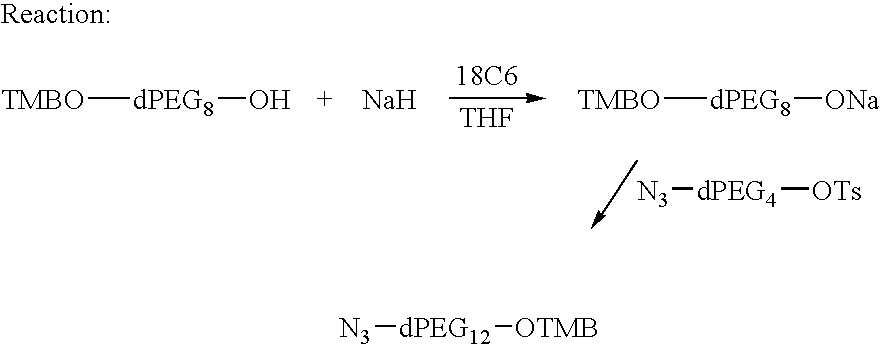Selective and specific preparation of discrete PEG compounds
a technology specific preparations, applied in the field of selective and specific preparation of discrete peg compounds, can solve the problems of inability to fine-tune the behavior of these systems, limited efficiency of a number of theapeutic proteins, and inability to meet the requirements of a wide range of applications, so as to improve the ability to purify intermediates
- Summary
- Abstract
- Description
- Claims
- Application Information
AI Technical Summary
Benefits of technology
Problems solved by technology
Method used
Image
Examples
example 1
Preparation of TMBO-dPEG20-OTMB or bis(O-TMB)-dPEG20
[0211]
95% Sodium hydride (3.5 g, 0.14 mole) was placed into a 1 L flask under argon and dry THF (300 mL) at −25° C. was added. Dry TMBO-dPEG8OH (52.3 g, 0.10 mole) was added slowly over about 20 minutes. The pot temperature was maintained below 15° C. bis-O-tosyl-dPEG4 was dissolved in THF (200 mL) and added slowly to pot. The reaction mixture was allowed to stir for 17 h as it warmed to rt. The reaction was monitored by tlc vs TMBO-dPEG8OH, eluting with 10% MeOH / CH2Cl2. The reaction was complete; the starting material was used up. The reaction mixture was filtered through a celite cake filter prepared with CH2Cl2. The filtrate was concentrated in vacuo; the resulting oil was extracted with CH2Cl2 (2×200 mL) and 10% (aq) NaCl (300 mL). The CH2Cl2 layer was isolated, dried over MgSO4, filtered and concentrated in vacuo to leave an oil. A column was prepared with 600 g of silica gel and hexane as needed. The crude product was placed ...
example 2
Preparation of elcosylethylene glycol (HO-dPEG20-OH)
[0214]
[0215]bis-(O-TMB)-dPEG20 (22.4 g, 1.9×10−3 mole) was placed into a 1 L flask under argon and dry CH2Cl2 (300 mL) at 0° C. Flask and contents were maintained at about 0° C. for 4 h while TFA (100 mL) dissolved in CH2Cl2 (200 mL) was added drop wise. The reaction progress was monitored by tlc on silica gel plates eluting with TBME. The reaction was complete in about 4 h; the TMB group was cleaved no starting material was present. The solvent was removed in vacuo to leave 47.0 g of crude oil product. A column was prepared with 600 g of silica gel and hexane as needed. The crude product was placed onto column with hexane; a minimum of t-butylmethyl ether (TBME, 30 mL) was used to make a clean transfer. The column was eluted with hexane (4 L) and then as follows: (12 L) 50% TBME / hexane; (2 L) 10% MeOH / TBME; (2 L) 30% MeOH / TBME. Like fractions containing product were combined and concentrated in vacuo to give 5.5 g (32%). The produ...
example 3
Preparation of Azido-dPEG12-OTMB
[0219]
95% Sodium hydride (3.5 g, 0.14 mole) was placed into a 1 L flask under argon and THF (200 mL) and 18C6 (4.4 g) was added at rt. TMBO-dPEG8OH (50 g, 0.10 mole) dissolved in dry THF (75 mL) was added to pot at RT. There was an evolution of hydrogen gas. The addition took about 3 hr with stirring. After a total of 50 minutes, N3-dPEG4OTs (38.6 g, 0.10 mole) dissolved in THF (75 mL) was added. The reaction mixture was stirred for about 17 h at rt under argon. The reaction solution was monitored by tlc on silica gel plates, eluting with 10% MeOH / CH2Cl2 vs. N3-dPEG4OTs. The reaction was about 90% complete. Therefore, DMAC (75 mL) was added and the reaction was heated under reflux for about an hour. The reaction was complete by tlc, that is, all the N3-dPEG4OTs was used up and only one new product was observed. A column was prepared with silica gel (600 g) and hexane (6 L) as needed. The crude product was pre-absorbed on silica gel (100 g) and placed ...
PUM
| Property | Measurement | Unit |
|---|---|---|
| temperature | aaaaa | aaaaa |
| molecular weight distributions | aaaaa | aaaaa |
| molecular weight distributions | aaaaa | aaaaa |
Abstract
Description
Claims
Application Information
 Login to View More
Login to View More - R&D
- Intellectual Property
- Life Sciences
- Materials
- Tech Scout
- Unparalleled Data Quality
- Higher Quality Content
- 60% Fewer Hallucinations
Browse by: Latest US Patents, China's latest patents, Technical Efficacy Thesaurus, Application Domain, Technology Topic, Popular Technical Reports.
© 2025 PatSnap. All rights reserved.Legal|Privacy policy|Modern Slavery Act Transparency Statement|Sitemap|About US| Contact US: help@patsnap.com



